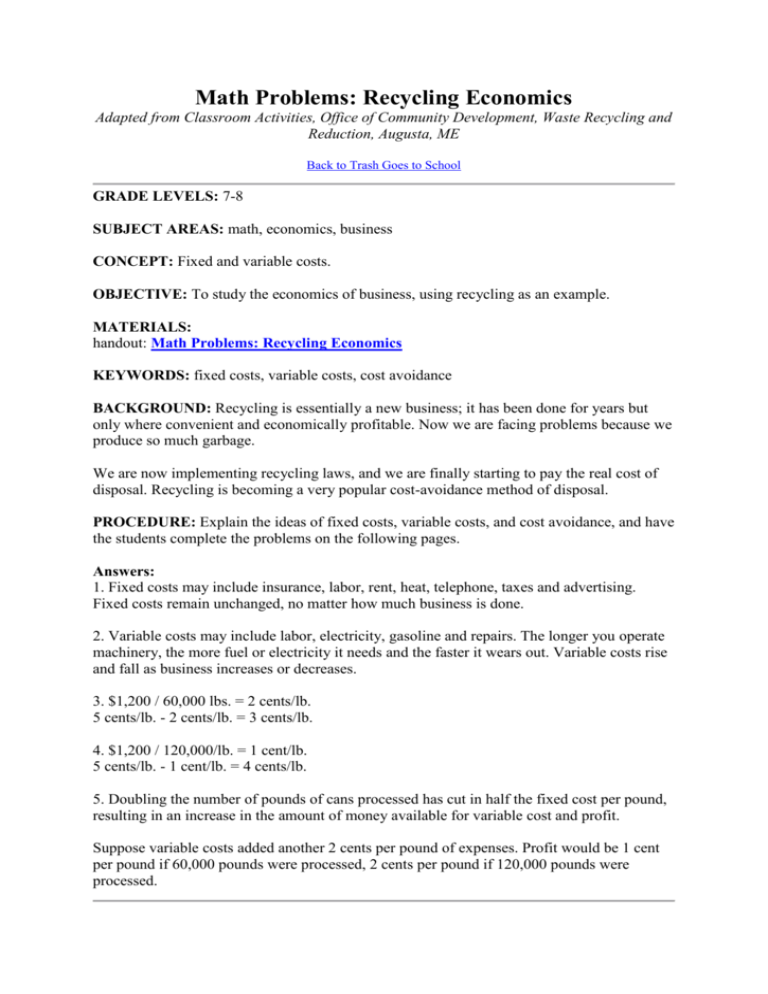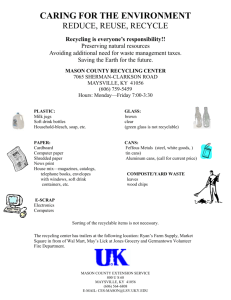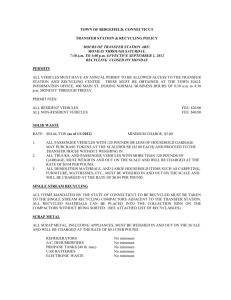Math Problems: Recycling Economics
advertisement

Math Problems: Recycling Economics Adapted from Classroom Activities, Office of Community Development, Waste Recycling and Reduction, Augusta, ME Back to Trash Goes to School GRADE LEVELS: 7-8 SUBJECT AREAS: math, economics, business CONCEPT: Fixed and variable costs. OBJECTIVE: To study the economics of business, using recycling as an example. MATERIALS: handout: Math Problems: Recycling Economics KEYWORDS: fixed costs, variable costs, cost avoidance BACKGROUND: Recycling is essentially a new business; it has been done for years but only where convenient and economically profitable. Now we are facing problems because we produce so much garbage. We are now implementing recycling laws, and we are finally starting to pay the real cost of disposal. Recycling is becoming a very popular cost-avoidance method of disposal. PROCEDURE: Explain the ideas of fixed costs, variable costs, and cost avoidance, and have the students complete the problems on the following pages. Answers: 1. Fixed costs may include insurance, labor, rent, heat, telephone, taxes and advertising. Fixed costs remain unchanged, no matter how much business is done. 2. Variable costs may include labor, electricity, gasoline and repairs. The longer you operate machinery, the more fuel or electricity it needs and the faster it wears out. Variable costs rise and fall as business increases or decreases. 3. $1,200 / 60,000 lbs. = 2 cents/lb. 5 cents/lb. - 2 cents/lb. = 3 cents/lb. 4. $1,200 / 120,000/lb. = 1 cent/lb. 5 cents/lb. - 1 cent/lb. = 4 cents/lb. 5. Doubling the number of pounds of cans processed has cut in half the fixed cost per pound, resulting in an increase in the amount of money available for variable cost and profit. Suppose variable costs added another 2 cents per pound of expenses. Profit would be 1 cent per pound if 60,000 pounds were processed, 2 cents per pound if 120,000 pounds were processed. Math Problems: Recycling Economics Most recycling business expenses are fixed costs. These costs remain the same no matter how many pounds of cans the center collects per month. Other expenses depend on how many cans the center collects. These are called variable costs. 1. Can you list some examples of fixed costs that a recycling center might have? ___________________________________________________________________________ _________ 2. Can you list some examples of variable costs that a recycling center might have? ___________________________________________________________________________ _________ 3. If a recycling center's fixed costs total $1,200 a month and 60,000 pounds are being processed, how much is being spent per pound for fixed cost? _____________________________________________ How much per pound is left for variable cost and profit out of a 5 cent per pound difference between the amount paid can collectors and the amount received from an aluminum company? _____________________________________________ 4. If the center can process 120,000 pounds a month without increasing fixed costs of $1,200, how much is then being spent per pound for fixed costs? _____________________________________________ How much per pound is left for variable costs and profit? _____________________________________________ 5. Can you explain why a recycling business may earn more money as the number of cans collected increases? ___________________________________________________________________________ ___________ Back to top








![School [recycling, compost, or waste reduction] case study](http://s3.studylib.net/store/data/005898792_1-08f8f34cac7a57869e865e0c3646f10a-300x300.png)